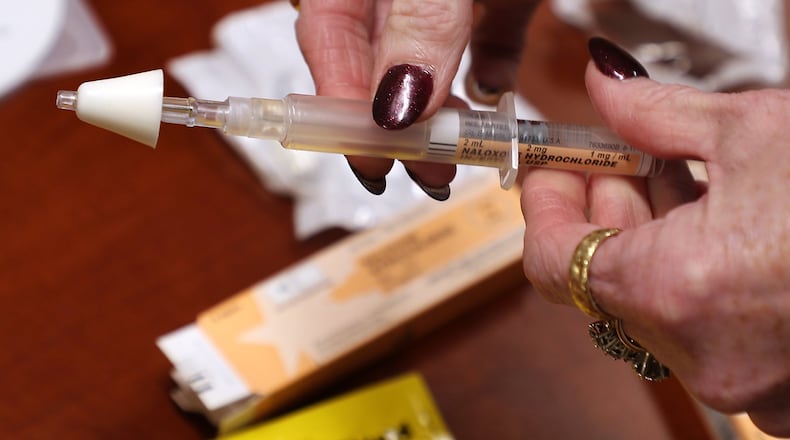MORE: Opioid overdoses followed auto plant closures, study says
“Our study shows that this change in the Ohio law allowed pharmacists to have more opportunity to participate in the management of patients addicted to opioids,” study’s lead faculty researcher Pam Heaton, a professor of pharmacy practice at UC’s Winkle College, said in a statement.
The pharmacy law change is part of broader efforts in recent years to expand access to the medication. These efforts include not just dispensing the medication but also building awareness and reducing stigma.
Neha Gangal, the study’s first author, said previous studies showed about a 14 percent reduction in overdose deaths in states where access to naloxone is increased. Ohio had the second-highest rate of opioid overdose deaths in 2017, according to the National Institute on Drug Abuse.
The bottom line, Gangal said, is that “legal barriers needed to be removed to address this important public health crisis. Pharmacists positively impact the health of patients every day and work tirelessly to address the opioid epidemic. By providing naloxone, pharmacists save lives.”
The majority of states allow pharmacists to dispense the medicine without a prescription under varying guidelines.
MORE: Butler County’s second needle exchange program in Fairfield targets ‘positive contacts’
The increase in naloxone prescriptions doesn’t surprise Middletown Health Commissioner Jackie Phillips “only because it was probably zero (before the law) as Narcan wasn’t really available” to the public.
“Right now, we think as Narcan as for heroin, but it’s for any opiate overdose,” Phillips said. “Narcan is just a wonderful thing because you can prevent a death.”
She said naloxone can help save the life of an older person who may have forgotten they already took one of their opiate pills before taking a second. Some doctors “proactively prescribe” naloxone to cancer and chronic pain patients, she said.
“I think it’s a good thing, the availability, especially the at-risk population that are susceptible to overdose,” said Scott Rasmus, Butler County Mental Health and Addiction Recovery Services Board executive director.
The 2,300 percent increase is "a very large number," but Rasmus said he also isn't surprised. There's a lot of access to free doses of Narcan, including with the Ohio Department of Health's Project DAWN which program participants receive a naloxone kit and training.
Brenda Pahl, Cedarville University director of experiential programs and assistant professor of pharmacy practice, said pharmacists are one of the more accessible health care providers, and patients can come in without having to make an appointment. Pahl said pharmacy students learn about naloxone in school.
“We have that knowledge, and we’d like to be able to use it help patients,” Pahl said.
Rasmus said “education is very important,” but so is continual monitoring and assessment of cutting-edge best practices and evidence-based practices, as well as continuing to provide Narcan access to the general public, especially the at-risk population.
“We’re always tracking research and what’s on our radar and what we hear from different channels,” he said. “We’re always trying to do one better.”
Overdose deaths in Butler County have dropped in recent years after reaching a record high 232 in 2017. It’s dropped to 164 in 2018 and preliminary results indicate it’s at 156 for 2019, though Butler County Coroner officials believe that could rise when final end-of-the-year test results are returned. Of the 156 overdose deaths last year, 125 had an opioid detected, according to coroner spokesperson Martin Schneider. There were 61 methamphetamine overdose deaths last year, 49 of which also involved an opioid.
“More work needs to be done, and obviously we want to get to the point where the numbers are zero, which is very hard to obtain of course, but the more we can drive this down the better. I don’t think we can sit still … we need to investigate,” Rasmus said.
MORE: Miami-Luken case raises questions of who is responsible for opioid crisis
As of May 2019, approximately 75 percent of community pharmacies in Ohio were registered to dispense naloxone without a prescription.
In the study, the research team compared 18 months of post-policy data to pre-policy data from Ohio’s Medicaid records and the database of the Kroger Ohio pharmacies, which includes prescriptions for patients with all types of insurance, not just Medicaid.
Out of Ohio Medicaid recipients, the total number of patients receiving naloxone increased from 183 patients in the pre-policy period to 3,847 patients in the post-policy period.
The analysis using the Kroger data confirmed an increase in the number of naloxone prescriptions dispensed for all types of insurance, including cash prescriptions. Kroger and CVS in February 2016 announced their pharmacies would dispense naloxone without a prescription.
Researchers also found that low-employment counties had 18 percent more naloxone prescriptions dispensed per month compared to high employment counties.
Heaton said the uptick in low-employment areas is most likely because the local pharmacy is often the sole health care contact for people living in these locations.
Lori Erion, Families of Addicts founder, said it’s a good initiative but also pointed out that Narcan is not free at a pharmacy, and there are other ways to get access for free in Dayton.
Families of Adicts had held Narcan training through 2019 where attendees received the medication for free. Every Wednesday at noon at Samaritan CrisisCare, at the Elizabeth Place campus in Dayton, there is free Narcan training and attendees receive free medication.
She said in one example, a Rite Aid near her had a display promoting Narcan, which she thought was great, but people sometimes have bad experiences in line at a pharmacy getting medication related to addiction.
What is naloxone?
Naloxone, also known as the brand name Narcan, is an opioid antagonist used to counter the effects of opioid overdoses, such as with morphine and heroin.
Naloxone works by blocking the effects of opioids on the brain. Opioids bind to receptors in the brain but naloxone has an even stronger attraction to the brain receptors.
“So it attaches and pushes off the opioid,” said Brenda Pahl, Cedarville University director of experiential programs and assistant professor of pharmacy practice. She said this lets the person breathe normally again.

